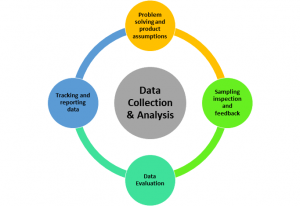

- Every valuable insight obtained from data helps the organization take the right decision.
- Helps the organization realize what their customers need and scrutinize any existing problem.
- Decisions based on a steady stream of data will induce more factual decisions rather than instinctive decisions.
- Helps structure the growth of both the product and the organization.
- Ensures a better plan in place for building new products.
- Helps to increase the efficiency of product managers and enables them to jot down a plan for smooth launch of the product in a creative and effective way.
- Tracks the evolution of product management.
- Better management of stakeholders and align the product team.
- Decisions taken based on data helps in better forecasting, marketing, business decisions and other core strategic goals.
- Data-driven concepts and decisions help leverage data for the organization and identify new revenue streams.
Problem solving and product assumptions: Problem solving is the key feature of any product management cycle. The major decision that needs to be taken into account is the criticality of the problem and the time involved in solving the same. As we ideate to make a better decision, the one that is backed with data always takes the upper hand. The potential features and assumptions of the product can be built on the data collected and improved by validating the same. Data lies as the base of any product story-line and is the foundation for any product strategy.
Sampling inspection and feedback: The product samples should be inspected based on the data collected and the feedback received from the customers. The best way to improve a product and its sales is by implementing the feedback received from the customers and making the product a customer satisfactory one. According to Product Craft, “A number of software companies offer design partner programs where they recruit customers to test and validate the features of a product before the product gets announced as GA (general availability) in the marketplace.”2
Data analysis: Data analysis or data evaluation plays an important role in determining the growth of a product. The data collected from customer experience or usability improvement are certain qualities that adhere to professionalism in building a product with facts. It is necessary to maintain a centralized database and enhance a structured data governance for a better outcome of the product and the organization. An analysis of the data collected helps the organization to determine a roadmap which would help them reduce risks and avoid operational losses.
Tracking and reporting data in the right format: Tracking and reporting of data paves a way for the sales and marketing teams to determine and build a pipeline to launch the product in the market. The data collected should be formulated in the right format as it would help with metrics of usage frequency and retention that are two major key factors that determine the sale of the product. To take a data-driven decision, it is important to keep in mind the following factors, customer conversion, product retention, and engagement scores.

- Acquire the art of positioning your vendors. Gartner uses the “Magic Quadrant” methodology in their research to show the market positioning of vendors. The vendors involved should be segregated based on their ability to execute and how much they can contribute towards accomplishing the organization’s vision.
- List down potential benefits of your data which can directly impact the productivity of the organization.
- Use your data as a tactical prediction tool and invest in collecting the right data, this would help you tailor your decisions based on the obtained predictions.
- Improve your data tech stack regularly, this helps your organization stay updated and make use of the relevant technologies.
- Maintain a repository of data (a single source of truth), and later make it accessible to everyone in the organization and encourage them to work based on it.
- Provide data preparation tools such as Altair, Infogix, etc., that help enhance data driven decisions.
- Adhere to a goal-oriented approach and implement modern data governance practices.
The journey to become a data-driven organization can evolve. But the major concern is the momentum lapses that happen once the project is over. The key to growing your organization is to be patient, disciplined and endure the strenuous yet fruitful path to becoming a data-driven organization. As W. Edwards Deming quotes, “Without data, you’re just another person with an opinion.”












